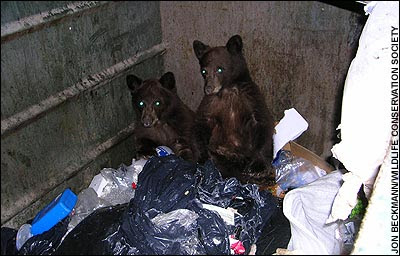I just returned from western Montana, where I appeared several places to promote my new book: Grizzly Wars: The Public Fight Over the Great Bear.
I found that local attitudes toward grizzlies differed depending on where I was. In the Bitterroot Valley south of Missoula, where grizzlies have been absent for years, a resident of Salmon, just across the border in Idaho, described the stormy public hearing eight years ago over reintroducing grizzlies into the Bitterroots. The mayor warned wildlife officials at the hearing that he would charge them with murder if anyone around Salmon was killed as a result of bringing back the bears.
In Hamilton, unofficial capital of Montana's Bitterroot Valley, locals told me that grizzly opponents are still vocal, yet a silent but growing majority supports reintroduction. New residents from California and elsewhere. I was told, are moderating local attitudes.
A woman from Helena who likes to hike told me that she doesn't stay home because of grizzlies. She does not hike alone, but she and her friends hike all the time in grizzly country, and they don't wear bells or shout to avoid surprise encounters.
In Butte, a man told me that he thought the biggest problem in managing grizzlies was "too many people."
The clearest message came from a newspaper reporter I met with in Kalispell. He's been covering public land and wildlife issues for many years, spends a lot of time in the hills, and regularly reports in the local paper on grizzly bear news. Sitting between the Cabinet-Yaak and Northern Continental Divide grizzly bear recovery areas, Kalispell is familiar with grizzlies. "I know a lot of rednecks around here and none of them complain about grizzlies," he says. "If a grizzly gets into someone's chicken coop or whatever, it makes for some good bar talk, but that's all." He was surprised to hear about anti-bear attitudes elsewhere. "You'll see bumper stickers that say 'Kill Wolves', but I've never seen one about grizzlies." he insists. "They're just part of the terrain."
submitted by David Knibb, author
Grizzly Wars: The Public Fight Over the Great Bear
I found that local attitudes toward grizzlies differed depending on where I was. In the Bitterroot Valley south of Missoula, where grizzlies have been absent for years, a resident of Salmon, just across the border in Idaho, described the stormy public hearing eight years ago over reintroducing grizzlies into the Bitterroots. The mayor warned wildlife officials at the hearing that he would charge them with murder if anyone around Salmon was killed as a result of bringing back the bears.
In Hamilton, unofficial capital of Montana's Bitterroot Valley, locals told me that grizzly opponents are still vocal, yet a silent but growing majority supports reintroduction. New residents from California and elsewhere. I was told, are moderating local attitudes.
A woman from Helena who likes to hike told me that she doesn't stay home because of grizzlies. She does not hike alone, but she and her friends hike all the time in grizzly country, and they don't wear bells or shout to avoid surprise encounters.
In Butte, a man told me that he thought the biggest problem in managing grizzlies was "too many people."
The clearest message came from a newspaper reporter I met with in Kalispell. He's been covering public land and wildlife issues for many years, spends a lot of time in the hills, and regularly reports in the local paper on grizzly bear news. Sitting between the Cabinet-Yaak and Northern Continental Divide grizzly bear recovery areas, Kalispell is familiar with grizzlies. "I know a lot of rednecks around here and none of them complain about grizzlies," he says. "If a grizzly gets into someone's chicken coop or whatever, it makes for some good bar talk, but that's all." He was surprised to hear about anti-bear attitudes elsewhere. "You'll see bumper stickers that say 'Kill Wolves', but I've never seen one about grizzlies." he insists. "They're just part of the terrain."
submitted by David Knibb, author
Grizzly Wars: The Public Fight Over the Great Bear







